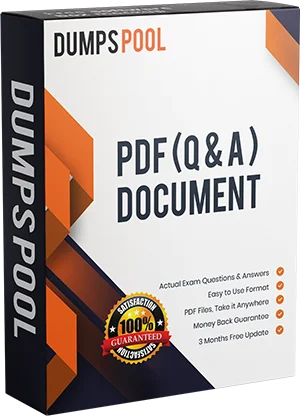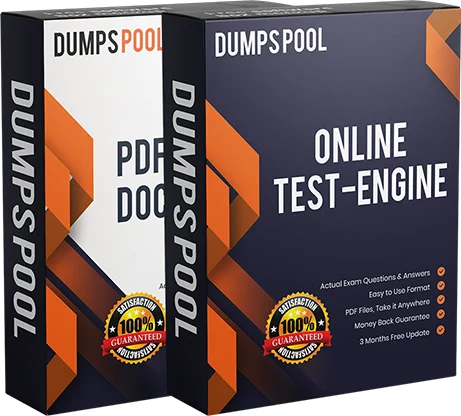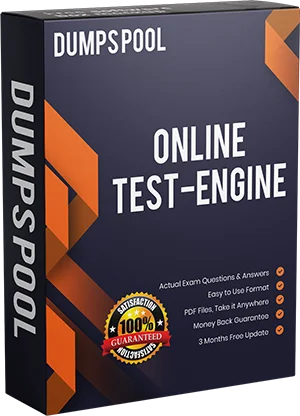PDF Only

$35.00 Free Updates Upto 90 Days
- OGEA-103 Dumps PDF
- 105 Questions
- Updated On July 26, 2024
PDF + Test Engine

$60.00 Free Updates Upto 90 Days
- OGEA-103 Question Answers
- 105 Questions
- Updated On July 26, 2024
Test Engine

$50.00 Free Updates Upto 90 Days
- OGEA-103 Practice Questions
- 105 Questions
- Updated On July 26, 2024
How to pass The Open Group OGEA-103 exam with the help of dumps?
DumpsPool provides you the finest quality resources you’ve been looking for to no avail. So, it's due time you stop stressing and get ready for the exam. Our Online Test Engine provides you with the guidance you need to pass the certification exam. We guarantee top-grade results because we know we’ve covered each topic in a precise and understandable manner. Our expert team prepared the latest The Open Group OGEA-103 Dumps to satisfy your need for training. Plus, they are in two different formats: Dumps PDF and Online Test Engine.
How Do I Know The Open Group OGEA-103 Dumps are Worth it?
Did we mention our latest OGEA-103 Dumps PDF is also available as Online Test Engine? And that’s just the point where things start to take root. Of all the amazing features you are offered here at DumpsPool, the money-back guarantee has to be the best one. Now that you know you don’t have to worry about the payments. Let us explore all other reasons you would want to buy from us. Other than affordable Real Exam Dumps, you are offered three-month free updates.
You can easily scroll through our large catalog of certification exams. And, pick any exam to start your training. That’s right, DumpsPool isn’t limited to just The Open Group Exams. We trust our customers need the support of an authentic and reliable resource. So, we made sure there is never any outdated content in our study resources. Our expert team makes sure everything is up to the mark by keeping an eye on every single update. Our main concern and focus are that you understand the real exam format. So, you can pass the exam in an easier way!
IT Students Are Using our TOGAF Enterprise Architecture Combined Part 1 and Part 2 Exam Dumps Worldwide!
It is a well-established fact that certification exams can’t be conquered without some help from experts. The point of using TOGAF Enterprise Architecture Combined Part 1 and Part 2 Exam Practice Question Answers is exactly that. You are constantly surrounded by IT experts who’ve been through you are about to and know better. The 24/7 customer service of DumpsPool ensures you are in touch with these experts whenever needed. Our 100% success rate and validity around the world, make us the most trusted resource candidates use. The updated Dumps PDF helps you pass the exam on the first attempt. And, with the money-back guarantee, you feel safe buying from us. You can claim your return on not passing the exam.
How to Get OGEA-103 Real Exam Dumps?
Getting access to the real exam dumps is as easy as pressing a button, literally! There are various resources available online, but the majority of them sell scams or copied content. So, if you are going to attempt the OGEA-103 exam, you need to be sure you are buying the right kind of Dumps. All the Dumps PDF available on DumpsPool are as unique and the latest as they can be. Plus, our Practice Question Answers are tested and approved by professionals. Making it the top authentic resource available on the internet. Our expert has made sure the Online Test Engine is free from outdated & fake content, repeated questions, and false plus indefinite information, etc. We make every penny count, and you leave our platform fully satisfied!
The Open Group OGEA-103 Exam Overview:
| Aspect | Details |
|---|---|
| Exam Name | Open Group OGEA-103 |
| Exam Cost | $320 USD |
| Total Time | 90 minutes |
| Available Languages | English, Japanese, Simplified Chinese |
| Passing Marks | 60% |
| Exam Format | Multiple Choice Questions (MCQs) |
TOGAF Enterprise Architecture Combined Part 1 and Part 2 Exam Topics Breakdown
| Domain | Weight (%) | Description |
|---|---|---|
| Business Architecture Fundamentals | 30% | Understand basic concepts and principles of business architecture. |
| Business Architecture Development Process | 30% | Know the phases, activities, and deliverables of business architecture development. |
| Business Architecture Governance and Management | 40% | Understand governance, roles, responsibilities, and compliance aspects of business architecture. |
Frequently Asked Questions
Question # 1
Which of the following is included as part of Architecture Governance1?
A. Ensuring compliance with internal and external standards and regulatory obligations
B. Creating and maintaining the Statement of Architecture Work though out the ADM cycle
C. Managing Stakeholders and their requirements
D. Interacting with the CxO level on Enterprise Architecture
Question # 2
Exhibit Consider the illustration showing an architecture development cycle Which description matches the phase of the ADM labeled as item 1?
A. Conducts implementation planning for the architecture defined in previous phases
B. Provides architectural oversight for the implementation
C. Operates the process of managing architecture requirements
D. Establishes procedures for managing change to the new architecture
Question # 3
Which of the following is the ability to develop use and sustain the architecture of a particular enterprise using architecture to govern change?
A. An EA Capability
B. An EA repository
C. An EA framework
D. An Enterprise Architecture
Question # 4
What is used lo structure architectural information in an orderly way so that it can be processed to meet stakeholder needs?
A. A Stakeholder Map
B. An Architecture Framework
C. Content Metamodel
D. An EA Library
Question # 5
Complete the sentence A set of architecture principles that cover every situation perceived meets the recommended criteria of_______________
A. consistency
B. robustness
C. stability
D. completeness
Question # 6
What are the four dimensions used to scope an architecture?
A. Business Data Application Technology
B. Strategy Segment Capability Budget
C. Breadth Depth Time Period Architecture Domains
D. Strategy Portfolio Project Solution Delivery
Question # 7
Complete the sentence A business scenario describes______________
A. shortfalls between the Baseline and Target Architectures
B. business domain gaps such as cross-training requirements
C. business and technology environment in which those problems occur
D. general rules and guidelines tor the architecture being developed
Question # 8
Consider the following statement: According to the TOGAF Standard a governed approach of a particular deliverable will ensure a system of continuous monitoring to check integrity changes decision-making and audit of all architecture-related activities Which deliverable is being referred to?
A. An Architecture Contract
B. The Architecture Definition Document
C. The Architecture Vision
D. The Statement of Architecture Work
Question # 9
Complete the sentence When considering agile development Architecture to Support Project will identify what products the Enterprise needs the boundary of the products and what constraints a product owner has. this defines the Enterprise's___________.
A. operations
B. backlog
C. workflow management
D. lifecycle economics
Question # 10
Which of the following is a responsibility of an Architecture Board?
A. Conducting assessments of the maturity level of architecture discipline within the organization
B. Allocating resources for architecture projects
C. Creating the Statement of Architecture Work
D. Establishing targets for re-use of components
Question # 11
What is an objective of the ADM Implementation Governance Phase?
A. To provide continual monitoring of the governance framework
B. To ensure conformance for the target architecture
C. To finalize the Implementation and Migration Plan
D. To establish the resources for architecture governance
Question # 12
Consider the following statements 1 A whole corporation or a division of a corporation 2 A government agency or a single government department 3 Partnerships and alliances of businesses working together such as a consortium or supply chain What are those examples of according to the TOGAF Standard?
A. Enterprises
B. Business Units
C. Organizations
D. Architectures Scopes
Question # 13
Complete the sentence The purpose of the Preliminary Phase is to_____________.
A. describe the target architecture
B. define the enterprise strategy
C. identify the stakeholders and their requirements
D. architect an Enterprise Architecture Capability
Question # 14
Which of the following best describes a purpose of the Gap Analysis technique?
A. To validate non-functional requirements
B. To establish quality metrics for the architecture
C. To determine service levels for the architecture
D. To identify missing functions
Question # 15
Which section of the TOGAF template for Architecture Principles should describe the relationship to other principles?
A. Name
B. Rationale
C. Statement
D. Implications
Question # 16
What provides context for architecture work, by describing the needs and ways of working employed by the enterprise?
A. Architecture Contracts
B. Business principles business goals, and business drivers
C. Strategy and vision
D. Stakeholder needs
Question # 17
Which statement about Requirements Management is most correct?
A. The purpose of Requirements Management is to process change requests
B. Stakeholder requirements are captured once in Phase A and managed throughout the ADM cycle
C. Requirements Management is a step of all ADM Phases
D. Requirements Management and stakeholder engagement are placed at the center of architecture development
Question # 18
Complete the following sentence. In the ADM documents which are under development and have not undergone any formal review and approval process are_______________.
A. Called ‘’draft’’
B. Invalid
C. In between phases
D. Known as ‘’Version 0.1’’
Question # 19
Which of the following best describes the class of information known as the Reference Library within the Architecture Repository?
A. Guidelines and templates used to create new architectures
B. Specifications to which architectures must conform
C. A record of the governance activity across the enterprise
D. Processes to support governance of the Architecture Repository
Question # 20
Which of the following supports the need to govern Enterprise Architecture?
A. The Architecture Project mandates the governance of the target architecture
B. The TOGAF standard cannot be used without executive governance
C. Best practice governance enables the organization to control value realization
D. The Stakeholders preferences may go beyond the architecture project scope and needs control
Question # 21
Complete the sentence The purpose of Enterprise Architecture is to_______________.
A. take major improvement decisions
B. control the bigger changes
C. guide effective change
D. govern the stakeholders
Leave a comment
Your email address will not be published. Required fields are marked *